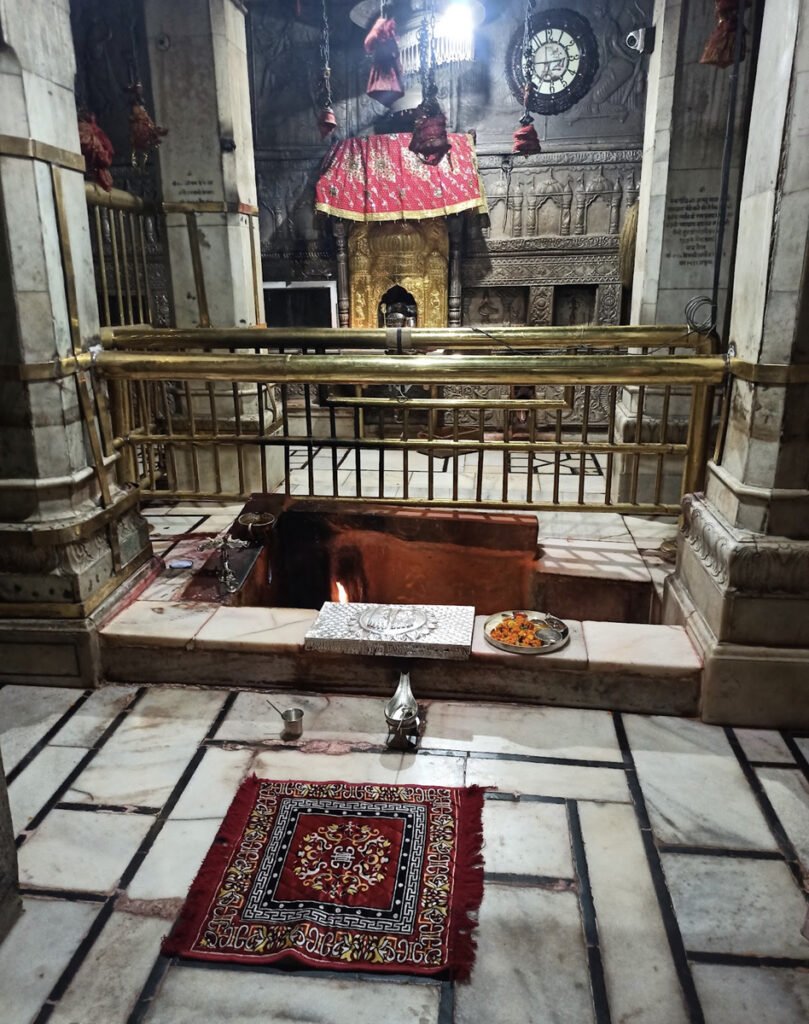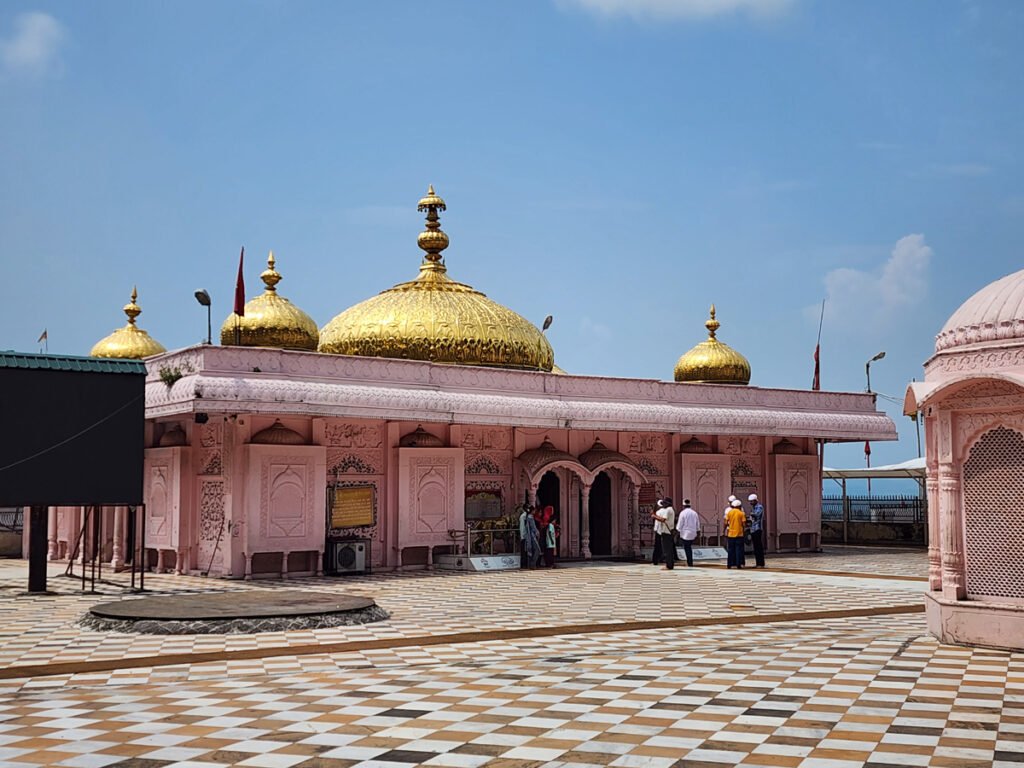Jwala Ji Temple Jwalamukhi Kangra
Jwala Ji Temple is located in Jwalamukhi town, Kangra district of Himachal Pradesh. It is one of the ancient temples in India. The temple is built against a wooded spur in the Indo-Sikh style, it has a dome that was gilded by Mughal Emperor Akbar. There is a mystic yantra covered by shawls and ornaments which is worshiped by chanting mantras. Here puja is performed in a phased manner and goes the whole day. Aarti is given five times a day. Shringar Aarti, Mangal Aarti, Madhyayan Kaal Aarti, Sayan Kaal Aarti and Shaiyya Aarti.

Contents
- 1 Significance of Jwala Ji Temple:
- 2 Legend of Jwala Ji Temple:
- 3 Jwala Ji Temple Mystery:
- 4 Places to visit near Jwala Ji Temple:
- 5 FAQ:
- 5.0.1 What is Jwala Ji Temple?
- 5.0.2 Where is Jwala Ji Temple located?
- 5.0.3 What is unique about Jwala Ji Temple?
- 5.0.4 How does the flame in Jwala Ji Temple stay lit?
- 5.0.5 What is the significance of Jwala Ji Temple?
- 5.0.6 What is the best time to visit Jwala Ji Temple?
- 5.0.7 Are there any rituals or ceremonies at the temple?
- 5.0.8 Is there an entry fee to visit Jwala Ji Temple?
- 5.0.9 Is there any nearby accommodation?
- 5.0.10 Is photography allowed inside the temple?
- 6 How to reach Jwala Ji Temple:
- 7 Google Maps:
Significance of Jwala Ji Temple:
- According to the mythology Daksha yagna and Sati self-immolation, it is the holy place where the “Tongue” fell down.
- Here the goddess is worshipped in the form of flame.
- There is an eternal flame inside the natural cave where we can find flames coming out continuously. Devotees believe that there are seven flames and some say it is nine flames and they are called sisters of the goddess. Devotees also believe that the flame is being burned from ancient times.
Legend of Jwala Ji Temple:
Once a cowherd noticed that his cow was not giving milk. He wanted to know the reason behind the scene, when he followed the cow he noticed that the cow was feeding a small girl who came from the forest and disappeared in a flash of light. Then the cowherd narrated the whole story to the king when the king tried to see the spot, he couldn’t. Later after a few years, Cowherd said that he found a divine flame where he saw a girl previously. Then King visited the place and had a vision of the flame. He later constructed a temple and appointed priests to worship. In a later period, it was visited by Pandavas who renovated the temple.
It was Dhyanu Bhagat who was an ardent devotee of goddess Jwalaji who spread the glory of the goddess. During the rule of Akbar, he got to know the spreading and summoned Bhagat to behead his horse and told him to reattach the head of the horse if his goddess was so powerful. Then Bhagat started worshipping the goddess day and night when all his efforts went in vain he cut his own head and offered it to the goddess. Jwala Ji appeared as an eternal power riding on a lion and attached both horse and Bhagat. Ma also offered a boon that she would accept minimal offers like coconut as their devotion. Also, the deity is worshipped by offering Rabri (thickened milk sweet), mishri (rock sugar), and seasonal fruits.
Explore More Temples>> Avanti Maa Gadkalika Temple Ujjain
Jwala Ji Temple Mystery:
The main attraction of the Jwala Ji Temple is the natural eternal flame that burns in the temple’s sanctum sanctorum. This flame is said to represent the Goddess’s manifestation as the “eternal flame of knowledge.” The flame emerges from nine different points in the rock and is considered highly sacred by devotees.
The mystery lies in the fact that despite various attempts to extinguish or understand the source of the flame, it has remained burning for centuries. Scientists and researchers have tried to explain the phenomenon, but no conclusive explanation has been found. Some theories suggest that it could be due to natural gas seepage or underground coal deposits, while others attribute it to the divine presence of the Goddess herself.
Explore More Temples>> Katyayani Shakti Peeth Vrindavan

Places to visit near Jwala Ji Temple:
Kangra Fort: The Kangra Fort is one of the oldest and largest forts in the Himalayas and is located about 20 kilometers from Jwala Ji Temple. It’s a historically significant site with stunning architecture and panoramic views of the surrounding area.
Chamunda Devi Temple: This temple dedicated to the goddess Chamunda is about 15 kilometers from Jwala Ji Temple. It’s situated on the banks of the Baner River and is known for its beautiful surroundings and spiritual significance.
Dharamshala: Dharamshala, a popular hill station, is approximately 45 kilometers away from Jwala Ji Temple. It’s known for its Tibetan culture, monasteries, and the residence of the Dalai Lama. Don’t miss visiting McLeod Ganj, a suburb of Dharamshala, which is famous for its Tibetan market and peaceful atmosphere.
Palampur: Palampur is a picturesque town located around 60 kilometers from Jwala Ji Temple. It’s known for its lush tea gardens, scenic landscapes, and pleasant climate. You can also visit the Baijnath Temple, which is nearby.
Bir-Billing: If you’re an adventure enthusiast, Bir-Billing, around 85 kilometers from Jwala Ji Temple, is the place for you. It’s one of the world’s best paragliding spots and offers breathtaking views of the Himalayas.
Masroor Rock Cut Temple: Located about 50 kilometers from Jwala Ji Temple, the Masroor Rock Cut Temple complex is a group of monolithic rock-cut temples with intricate carvings and historical significance.
Kareri Lake: Situated around 80 kilometers from Jwala Ji Temple, Kareri Lake is a beautiful trekking destination surrounded by lush forests and alpine meadows.
Nadaun: Nadaun is a small town located about 35 kilometers away from Jwala Ji Temple. It’s known for its scenic beauty and the Beas River, making it a serene place to relax.
Baijnath Temple: The ancient Baijnath Temple, dedicated to Lord Shiva, is approximately 35 kilometers from Jwala Ji Temple. It’s known for its stunning architecture and historical significance.
Masrur Temples: Masrur Temples, also known as the “Himalayan Pyramids,” are a group of rock-cut temples around 40 kilometers from Jwala Ji Temple. These temples are known for their unique architecture and are a UNESCO World Heritage Site.
Explore More Temples>> Kanipakam Varasiddhi Vinayaka Swamy

FAQ:
What is Jwala Ji Temple?
Jwala Ji Temple is a sacred Hindu temple dedicated to Goddess Jwala Ji, the deity of flames. It is known for the continuously burning natural flame that emanates from the rock inside the temple.
Where is Jwala Ji Temple located?
Jwala Ji Temple is located in the town of Jawalamukhi in the Kangra district of Himachal Pradesh, India.
What is unique about Jwala Ji Temple?
The uniqueness of Jwala Ji Temple lies in the fact that it houses a natural flame that has been burning for centuries. The flame is said to emanate from a rock and is considered a divine manifestation of the Goddess.
How does the flame in Jwala Ji Temple stay lit?
The exact scientific explanation for the perpetually burning flame in the temple remains a mystery. It is believed to be a divine phenomenon and is not fueled by any natural source.
What is the significance of Jwala Ji Temple?
The temple is of great religious and spiritual significance to Hindus. It is one of the 51 Shakti Peethas, places of worship where various body parts of the goddess Sati (an incarnation of Shakti) are believed to have fallen. Jwala Ji Temple is associated with the tongue of Sati.
What is the best time to visit Jwala Ji Temple?
The temple can be visited throughout the year, but it is particularly crowded during Navratri, a Hindu festival dedicated to the worship of the Goddess, which usually falls in September or October.
Are there any rituals or ceremonies at the temple?
Devotees offer prayers and perform aartis (rituals involving the waving of lamps) at the temple. Some people also make offerings of ghee and other items to the divine flame.
Is there an entry fee to visit Jwala Ji Temple?
No, there is no entry fee to visit Jwala Ji Temple. It is open to all devotees and visitors.
Is there any nearby accommodation?
There are several hotels and guesthouses in the town of Jawalamukhi where visitors can stay. Dharamshala and Kangra are also nearby and offer additional lodging options.
Is photography allowed inside the temple?
Photography rules can vary, but it is advisable to inquire locally and respect the temple’s regulations regarding photography and mobile phone usage.
Explore More Temples>> Shree Trishrota Maa Bhramoree Debir Shaktipeeth Temple.

How to reach Jwala Ji Temple:
By Air:
The nearest airport to Jwala Ji Temple is the Kangra Airport, also known as Gaggal Airport (IATA: DHM). It is approximately 46 kilometers away from the temple. From the airport, you can hire a taxi or take a bus to reach the temple.
By Train:
The nearest major railway station to Jwala Ji Temple is the Pathankot Railway Station (approximately 120 kilometers away). From Pathankot, you can hire a taxi or take a bus to reach the temple. There is also a smaller railway station called Kangra Railway Station, but it is not as well-connected as Pathankot.
By Road:
From Pathankot: If you are coming from Pathankot, you can take the Pathankot-Mandi National Highway (NH-154) and then the NH-503 towards Jwala Ji Temple.
From Kangra: If you are starting from Kangra, you can take the NH-503 directly to the temple.
From Dharamshala: Jwala Ji Temple is approximately 35 kilometers from Dharamshala. You can take a taxi or bus from Dharamshala to reach the temple.
Local Transportation: Once you reach the town of Jwala Ji, you can hire a local taxi or use auto-rickshaws to reach the temple, which is situated a short distance from the town center.
